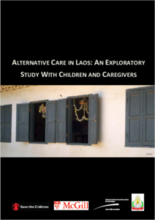This report summarizes the findings of a study on parental and alternative childcare in Luang Prabang (LPB) and Xayabury (XYB) provinces in Northern Lao People’s Democratic Republic (P.D.R.) The objectives were to document (a) existing family and community practices aimed at preventing parental separation and promoting parental care and family reintegration; and (b) alternative care arrangements for children separated or removed from, abandoned, or relinquished by their parents in these provinces.
The study found that there are few abandoned children in LPB and XYB. Positive child‐care practices and strong family and community ties result in most children being raised within their families. Children are sent to live with relatives mostly when parents pass away (orphans), separate/divorce, or remarry, or to obtain accommodation while they complete their (secondary or vocational) schooling. Financial need and education seem to be the key determinants of child separation and reunification. Other frequently mentioned reasons include employment of a parent or child (including upland farming and migratory work), children running away from home (e.g., due to domestic violence or substance use), and outsiders taking away children on promises of better living conditions or employment. Some boys around age 10 become novices in temples to access to education, secure basic needs, gain merit for self or family, build character, or relax during vacation. Decisions to send children to residential care are generally made by parents, often in consultation with relatives, the head of the village, and ministry officials.
Orphan children are generally cared for by relatives and, when these are not available, the village authority may appoint a guardian or send them to an SOS Children’s Village (SOSCV) or Ethnic Minority Boarding Schools (EMBSs) provided by the Ministry of Education and Sports (MoES). There is a widespread belief that children in residential care cannot go back to their parents unless they have “finished their study and have a job” or they are part of “middle and better off families.” Orphan children and children whose parents cannot provide for, may also be adopted by relatives or non‐relatives, but formal adoptions are rare. A common use of the term “adoption” to refer to informal fostering is widespread. When a couple cannot have their own children, they may try to adopt by “asking for children to live [with]” in a village or a hospital. Of particular concern in institutional care settings is the lack of follow‐up and ongoing assessment of the placement, and variables standards of care. Significant variation exists in the state of facilities and resources across EMBSs. Key informants also raised concerns about the lack of accurate, up‐to‐date information on the prevalence of formal and informal alternative care in the country as well as of systems to support alternative care placements. The report includes a number of recommendations including the need to better outline roles and responsibilities between the different ministries and strengthen the collaboration between all agencies working on alternative care for children. Standards of care and protection should also be developed, particularly for children who are in institutions.
©Save the Children, McGill University/CSSS de la Montagne, and National University of Laos

